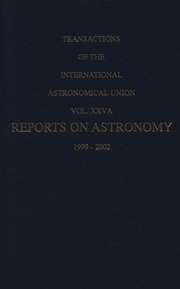No CrossRef data available.
Article contents
Commission 15: Physical Study of Comets, Minor Planets, and Meteorites
Published online by Cambridge University Press: 25 April 2016
Extract
The last three years have witnessed a growing interest in the physical properties of the small bodies in the solar system. Perhaps the most significant impetus to research on small bodies has been the imminent arrival of Comet Halley in the inner solar system. This famous comet, which was recovered in autumn 1982, has been the object of intense study during the past year as it has approached the sun and developed a tail. Much of the international, ground-based astronomical research on Halley has been coordinated through the International Halley Watch program. Spacecraft from several nations have been successfully launched (or soon will be, we hope) and are on their way to intercept the comet and make close-up observations and in situ measurements. The commencement of spacecraft study of small bodies marks a new era in comet/asteroid science and, in coordination with ground-based and Earth-orbital observations, will result in unprecedented new knowledge about the origin of the solar system and about solar system processes. Although Halley is receiving the most attention, interest is also high in Comet Giacobini-Zinner, the vicinity of which will be probed by a diverted American spacecraft in September 1985. Upcoming spacecraft studies of comets through 1986 are described at the end of the comet section of this report. Asteroid exploration by spacecraft is also anticipated to begin in the near future. The trajectory of the NASA Gailieo Mission to Jupiter has been changed to permit close-encounter observations of the large main-belt asteroid 29 Amphitrite in December 1986; these observations will be conducted on a “best effort” basis only a few months after launch of Galileo. Interest is also high in Europe, the Soviet Union, and the United States in possible spacecraft missions to additional comets and asteroids during the 1990’s. If these efforts are pursued, there will be a concomitant ground-based effort. The last three years have also witnessed extremely productive efforts to observe small bodies from Earth orbit. For example, the Infrared Astronomical Satellite discovered a comet in 1983, which made the closest approach to the Earth of any comet in centuries. IRAS made important discoveries and measurements of other comets and also assembled an immense database on infrared brightnesses of thousands of numbered and unnumbered asteroids. The planned launch of the Hubble Space Telescope next year highlights the continuing potential for applying extremely powerful instrumental techniques to the study of comets and asteroids from above the Earth’s atmosphere.
- Type
- Research Article
- Information
- Copyright
- Copyright © Reidel 1985


